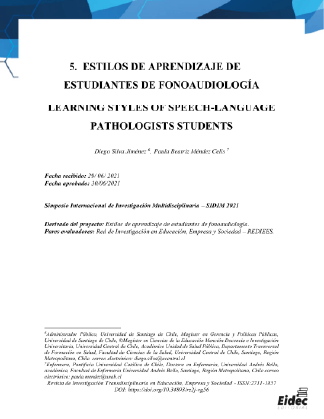V. LEARNING STYLES OF SPEECH-LANGUAGE PATHOLOGISTS STUDENTS
##plugins.themes.bootstrap3.article.main##
Abstract
All people learn differently, the way it is done is personal and individual; and it is the result of the mixture of multiple influences; the history, the genetic load, the modeling of the environment. The objective of the research was to identify the predominant learning styles in the students of the Speech-Language Pathologists career of a Chilean University. The methodology used in the research was quantitative, non-experimental, of a cross-sectional type, for the evaluation of learning styles in Speech-Language Pathologists students at a Chilean University. Learning styles were measured through the questionnaire for the identification of learning styles (General Directorate of the Bachillerato, 2004) based on the Herrmann Brain Quadrants model. The sample consisted of 28 students from the SpeechLanguage Pathologists career. The results obtained were that the students of the SpeechLanguage Pathologists career, present in the second year the predominance of the Left Cortical quadrant with 57%, in the third year, the dominance is the Right Cortical with 66.6% and in the fourth year it is Limbic Left with 31.8%. In conclusion, the learning styles of Speech-Language Pathologists students are different throughout their academic development per year, not coinciding with what is proposed in the literature, where health careers present a preference for the left hemisphere.
Download Statistics
##plugins.themes.bootstrap3.article.details##
Speech therapy, Learning styles, Higher education, Learning, Students
Gutiérrez, R., Campos, W. y Esparza. G. (2019) Los cuadrantes cerebrales: una posibilidad para conocer a nuestras normalistas. CONISEN. 1-8. http://www.conisen.mx/memorias2019/memorias/2/P541.pdf Hernández., Fernández. y Baptista, M.P. (2014) Metodología de la Investigación. 6° ed. McGRAW-HILL. Mexico Herrmann, N. (1982). Herrmann Brain dominance intrument. Lake Lure, NC: Applied Services. Herrmann, N. (1989). The creative brain. Búfalo: Brain books. Herrmann, N. (1998) The Theory Behind the HBDI and Whole Brain Technology. The HBDI Accreditation Process. Herrmann International. [online]: http://www.hbdi.com/ Keefe, J. (1988) Aprendiendo perfiles de aprendizaje: manual de examinador. Reston, VA: Asociación Nacional de Principal de Escuela de Secundaria. Ordóñez, F., Rosety-Rodríguez, M., Rosety-Plaza (2003) Análisis de los estilos de aprendizaje predominantes entre los estudiantes de ciencias de la salud.Rev. Enfermería global. (3) 1-6 http://revistas.um.es/eglobal/article/view/619/645 Parra KM, García J, Navarro N. (2017) Estilos de aprendizaje en los estudiantes de primer año de las carreras de Fonoaudiología y Kinesiología. Rev Educ Cienc Salud. 14(2):122-9. http://www.udec.cl/ofem/recs/anteriores/vol1422017/artinv14217e.htm Puente, A., Abarca, M., Mejía, S. (2012) Estilos de aprendizaje en estudiantes y profesores de segundo semestre de la carrera de ingeniería civil de la universidad de Colima. https://dialnet.unirioja.es/servlet/articulo?codigo=4659944 Puello, Plinio, Fernández, Diyina, & Cabarcas, Amaury. (2014). Herramienta para la Detección de Estilos de Aprendizaje en Estudiantes utilizando la Plataforma Moodle. Formación universitaria, 7(4), 15-24. https://dx.doi.org/10.4067/S0718- 50062014000400003 Salas-Cabrera, Jorge. (2014). Estilos de aprendizaje en estudiantes de la Escuela de Ciencias del Movimiento Humano y Calidad de Vida, Universidad Nacional, Costa Rica. Revista Electrónica Educare, 18(3), 159-171. http://www.scielo.sa.cr/scielo.php?script=sci_arttext&pid=S1409- 42582014000300009&lng=en&tlng=es.
Solari, G., Iratchet, M., Andrade, M. & Velasco, A. (2019). Estilos de aprendizaje en Fonoaudiología y Terapia Ocupacional en la Universidad de Antofagasta, Chile. Educación Médica Superior, 33(2), e1721. http://scielo.sld.cu/scielo.php?script=sci_arttext&pid=S0864- 21412019000200015&lng=es&tlng=es. Suazo, I. (2007). Estilos de Aprendizaje y su Correlación con el Rendimiento Académico en Anatomía Humana Normal. International Journal of Morphology, 25(2), 367-373. https://dx.doi.org/10.4067/S0717-95022007000200022 Velásquez, B., Remolina, N. y Calle, M. (2013) Análisis correlacional del perfil de dominancia cerebral de estudiantes de ciencias de la salud y estudiantes de ciencias sociales de la Universidad Colegio Mayor de Cundinamarca. Nova, 11(20), 71-82. Retrieved December 01, 2020, from http://www.scielo.org.co/scielo.php?script=sci_arttext&pid=S1794- 24702013000200008&lng=en&tlng=.v





